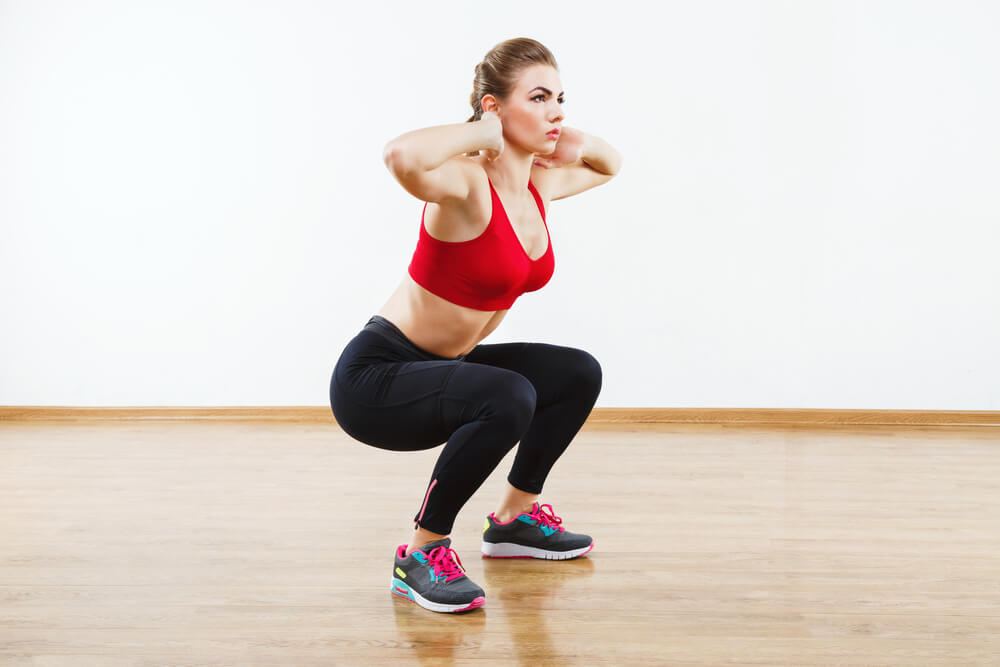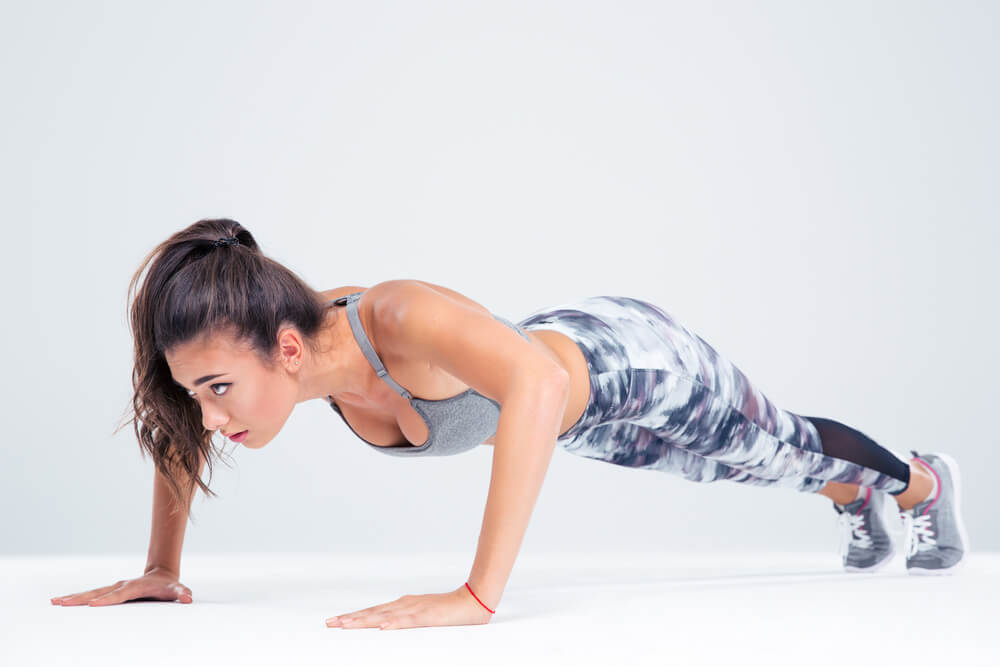Unlike many other workout types, bodyweight exercises do not actually require any special equipment, and can easily be carried out at home. By using nothing else but the weight of your body and the power of gravity, these 20 bodyweight exercises will help you to build muscle and burn fat, while giving yourself such a satisfying workout.
1. Squats

Squats are not only one of the most effective of bodyweight exercises, but are also the most natural, as this is the same way in which a baby would sit down.
While this may seem like a simple exercise, a squat works out all of the muscles in the lower body, and gives your core a boost as well, since you will be using your abdominal muscles to keep yourself upright.
However, make sure that your technique is correct when doing this exercise, otherwise you may cause more damage than good…
Stand with your feet shoulder-width apart and then bend your knees until your thighs are parallel to the ground. Use your heels to help you to stand back up straight again, squeezing your buttocks in and keeping your core tight while you do so.
2. Burpees
While burpees are quite intense, many would argue that this is the single most effective exercise in the world, as it works out almost every muscle group, combining cardio and strength into one exercise.
To do a burpee, these are the four steps that you must follow:
- Stand with your feet together, and then drop into a deep squat position with your hands on the floor
- Kick your feet backwards so that your body is in a plank position
- Jump your feet back into a low squat position
- Jump back up, with your arms reaching overhead
If you want to make this exercise a little easier to begin with, take out the last jump, and simply stand up at the end instead.
Or, if you want to make this exercise a little harder, add in a tuck jump just before the squat.
3. Push-Ups

Push-ups are great as they work out just about every muscle group in the upper body, from your back to your arms to your abs.
They are also easy to do, but you need to ensure that your position is correct…
Your shoulders should be lined up with your wrists, while your elbows should be tucked in towards your side. You should also be trying to get your hips and chest as close to the floor as possible while doing this exercise, without actually touching the floor.
4. Calf-Raise
The calf-raise is an extremely simple exercise, but can be adapted to suit your needs.
Here is what you need to do:
- Stand up straight and slowly rise up on your toes, until your heels are off the floor, but make sure that you keep your knees straight
- Hold the position briefly before coming back down and repeating
Wondering how to make this exercise a bit more challenging?
Try standing on a step while doing it, or bounce up and down quickly so that you get more reps in.
5. Step-Up
This is an exercise that requires a raised surface, such as a step, low chair or bench.
All you need to do is place one foot onto this surface and then step up on it, until your front leg is straight.
Hold this briefly before returning to your starting position, making sure that you step down rather than jump down.
6. Plank

When it comes to defining the core, the plank has become one of the most popular exercises.
Here are the steps to follow to correctly carry out a plank:
- Lie face down with your forearms touching the floor and your hands clasped
- Extend your legs behind you and rise up on your toes
- Tighten your core, and hold this position for as long as you can, making sure that your back is kept straight
7. Feet-Elevated Plank
Once you have mastered the standard plank, you can then move on to trying some of the many plank variations that are out there.
The feet-elevated plank is one of these, and is basically the same as a standard plank, but is carried out on a raised surface to make it more challenging.
Try it on something like a chair or low table first, as you do not want the surface to be too high.
8. Side Plank

Another plank variation, the side plank requires you to lie on your side, with just one foot, and one forearm, touching the floor.
Once you have done this, raise your body up slowly, making sure to keep it in a straight line.
Hold this for as long as you can before gently lowering yourself back down. Make sure that you do this exercise using both sides of your body.
9. Handstand Push-Up
Handstand push-ups will give your body a great workout, and are especially effective at building up the shoulders.
Haven’t yet mastered the handstand?
Use a wall to help you, placing your feet against this.
Once you can do this for 60 seconds, you can then begin incorporating push-ups into this.
10. Donkey Kicks

The donkey kick, also known as the back kick, works out a number of different muscle groups:
- The core
- All three muscles in the buttocks
- The lower back
- The legs
Here is what you need to do:
-
- Begin on the floor on all fours
- Bring your right knee in towards your chest, keeping your foot flexed
- Kick your right leg up behind you, and then bring it back down, keeping your knee bent while doing so
- Repeat this with the other leg
11. Crab Walk
The crab walk targets your triceps, glutes and your core, while also improving your coordination. While it may take a few days to master this move, it will not be long before you are speeding across the floor…crab-style, of course!
All you need to do is sit on the ground in a comfortable position, with your palms behind your hips. Then, pull your body up off the ground, so that your weight is resting on your hands and feet.
Use your left foot, and your right hand, to move yourself one step forward or backward, before repeating with the other hand and foot.
TOP TIP: Make sure that you keep your abdominal muscles engaged, and your hips lifted off the floor for the entire duration of the exercise.
12. Bicycle Crunches

Unlike regular crunches, bicycle crunches require deeper abdominal rotation and stabilization, which gives your core an intense workout.
They are also easy to do, with only a few steps to follow:
- Lie on the ground with your knees bent and hands behind your head
- Lift your legs off the ground and slowly make a pedalling motion, just like riding a bicycle
- Keep your hands behind your head, and, as each leg comes towards you, bring the opposing elbow over to meet it
13. Dragon Flag
Looking for a serious challenge?
Then the dragon flag is the exercise for you.
If you have not heard of this one before, here is what you need to do:
- Lie on your back and hold on to something behind your head
- Keeping your upper back on the floor, raise the rest of your body off of the floor
- Brace every muscle that you can in order to keep your body in a straight line
14. Side Lunges

When it comes to the majority of bodyweight exercises out there, these tend to move your body in one of two ways; up and down, or forward and back.
This is exactly why the side lunge is such a good exercise to incorporate into your workout, as it gets your body moving in a different way. This means that it will challenge your muscle fibers, ligaments, and tendons in a way that the rest of your workout does not.
To do this exercise, begin by standing with your feet apart, and then take a large step out towards your right. Bend your knee and push your buttocks back, while keeping your core tight and your chest lifted.
Return back to your starting position and then repeat on the other side.
Want to give your core even more of a challenge?
Try adding in a side leg lift with each lunge.
15. Sit-Up
Sit-ups are quite a popular exercise, and this is because they are also one of the most challenging of bodyweight exercises.
Why?
Since you are not able to use your arms or legs to help you to sit up, you end up using a far greater amount of abdominal strength.
Simply lie on the ground with your knees bent, and then contract your abs to lift your body up off the ground. Make sure that you limit the amount of movement that your lower back does.
Finding standard sit-ups too challenging?
Try doing a crunch variation instead, until you build up some abdominal strength.
16. Twisting Sit-Up

If you are bored of regular sit-ups, try giving the twisting sit-up a try instead, which is an advanced form of the standard version.
For those of you who are already familiar with sit-ups, this exercise will be easy to do. The only difference with this one is that at the top of each movement, you need to bring the opposite elbow towards your knee.
Make sure that you do not over-rotate your body, as this can cause quite a bit of damage over time.
17. Jumping Jacks
When it comes to the different types of exercise out there, jumping often gets a bad reputation. However, there is nothing quite like it when it comes to increasing bone density, so, if this is one of your aims, you may want to give this exercise a try.
Here are a few of the other benefits that jumping jacks can bring:
- One of the best plyometric exercises there is
- Provides a great cardio workout
- Will improve your speed and quickness
Ready to give it a go?
Simply jump up, spreading your legs to the side while lifting your arms at the same time. Once you land, jump back up and do it again.
Jumping jacks are also a great one to warm up with, so consider adding this to the start of your workout.
18. Squat Jacks

Squat jacks take jumping jacks to the next level, by throwing a squat in there too.
Here are the steps to follow:
-
- Stand with your feet together and your hands at your chest
- Jump so that your feet go outwards, but sit into a small squat at the same time
- Jump your feet back together to bring yourself back into your standing position
- Repeat
19. Tuck Jumps
Everyone has their own individual goals when it comes to working out, and if yours include improving your agility and power, while working on jumping higher, then tuck jumps are the way to go.
This is a powerful, yet fun, exercise that has been proven to strengthen just about every single part of the body, and is especially beneficial when it comes to heart health.
To begin with…
Stand up straight with your knees slightly bent, and then jump as high as possible.
Now for the tricky part…
While you are in the air, bring your knees in towards your chest, while extending the arms straight out, almost as though you are tucking your knees in.
Bend your knees slightly as you land, and then repeat the exercise.
20. Wall Sit

The wall sit works out a number of different muscle groups, including your hamstrings, glutes, quadriceps, and your core.
To do this exercise, follow these steps:
- Slide your back down a wall until your thighs are parallel to the ground, and your knees are directly over your ankles
- Keep your back straight, and hold this position for 60 seconds, before returning to standing position.
- Try to repeat this five times, although you may need to build up to this gradually.
If you want to give yourself an extra challenge, try adding in some bicep curls while you are “sitting”.
When it comes to working out, it is important to make sure that you do not push yourself too hard to begin with, as this may only end up deterring you. Instead, set yourself some realistic goals, and take the steps necessary to ensure that you stick to them.








